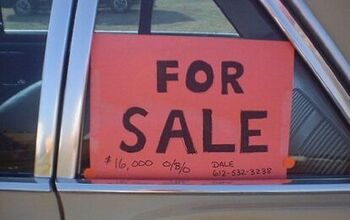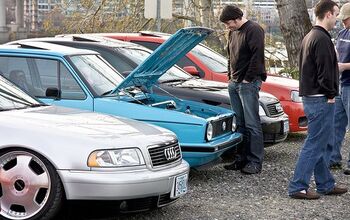How to Buy a Used Car - Pt. 1: First Contact
Used cars give automobile buyers the best possible bang for the buck– except when they don’t. As a professional dealer, I could tell you stories of used car calamities that would make public transportation seem like the only sensible option. Tales of stitched together death traps that looked as new as the day both cars were born. Cars with supposedly clean registration papers that turned out to be hotter than Peachtree Street in mid-August. Instead, I’m going to tell you how to buy a used car without getting your proverbial clock cleaned.
Finding an appropriate used car is a pretty simple business: decide what kind of car you want, research it online (especially model and brand-specific enthusiasts’ sites) and then go out and find one.
You can find a great car at a variety of sources: private, owner, independent used car dealer, used car superstores, new car dealer; even a “buy here / pay here” lot might stock a great vehicle or two (credit the law of averages). On a percentage basis, I’ve found that private owners and independent dealers offer the best bang for the buck. Conversely, your neighborhood impound lot or public auction is a no-no nadir.
When you make contact with the seller, ask for the car’s VIN (Vehicle Identification Number). That’s the government-mandated ID code welded onto the car’s chassis (and attached elsewhere), and listed on the car’s registration papers. Thank the seller for the info, tell them you’ll call them back, and hit the ‘Net.
Plug the car’s VIN number into Carfax’s or Autocheck’s on-line database. For a nominal fee, these sites will tell you if the car’s been flooded, torched, stolen, crashed, rebuilt, salvaged or had its odometer rolled back. Equally important, it’ll let you know if the car was a rental, a fleet vehicle or had a long series of owners (i.e. sporty models with neglectful owners are financial time bombs).
This due diligence must be done, but the information is far from perfect. Any damage not filed in an accident report won’t show up. Arbitration issues can also fall through the cracks. When TTAC alum Frank Williams checked an Audi he once owned, the report made no mention of the fact that Audi
bought back the car under Lemon Law provisions.
To fill the holes in a used car’s mission critical history, it pays to dig a little deeper.
Contact the service department at the brand-appropriate dealership and ask the service advisor for a maintenance report. By law, dealers can’t print out the information or give the owner’s name. But they CAN verbally report a car’s service history. If you’ve got the wrong dealership, contact the seller and ask where the car was serviced.
This brings us back to your most important source of car-specific information: the seller.
After you’ve secured the VIN and done your homework, call the seller back. There are dozens of excellent questions you can ask, and one you shouldn’t: what’s the price? Avoid negotiating price for the same reason you wouldn’t bid on a house without looking inside.
Here’s how I do it:
“I like to catch up on maintenance whenever I buy a car. Can you tell me where the car was serviced, what you’ve done lately and if there’s anything else I’ll need to do in the next year or so?”
“I usually have my cars inspected at ‘x’. If I like the car, would it be OK to have it inspected?”
I always use conditional words and phrases– “Can you… would… do you know…is it possible.” It’s non-threatening, and the polite approach encourages the owner to provide additional information.
Thank the seller; you’ll call them back when you’re ready to see the car in person.
If confidence is still high, it’s time to determine an appropriate price. Forget Edmunds, Kelly Blue Book and NADA. For popular late model used automobiles, eBay’s ‘Completed Items’ section is the only pricing guide that matters. Specifically, check out your prospective purchase’s green “ending price.” The number reflects the final purchase price for cars that actually sold in the marketplace.
If there aren’t any recent or enough listings, go to your local bank or credit union. Tell them you’re looking at buying a used car and ask them to print out an industry wide pricing guide called the Manheim Market Report (MMR).
The MMR lists wholesale and retail used car prices based on millions of recent transactions. Although the MMR is not for public consumption, almost all financial institutions with an auto lending department have access to this information.
Time for a bid? Nope. Time for a test drive.
Mr. Lang invites readers to share their used car buying advice and their used car triumphs and tragedies below.
He can be reached at steven.lang@alumni.duke.edu
More by Steven Lang
Latest Car Reviews
Read moreLatest Product Reviews
Read moreRecent Comments
- AZFelix 2015 Sonata Limited72k when purchased, 176k miles currentlyI perform all maintenance and repairs except for alignment, tire mounting, tire patching, and glass work (tint and passenger left due to rock hit). Most parts purchased through rockauto.com.Maintenance and repairs during three years of ownership:Front rotors and all brake pads upgraded shortly after purchase.Preparing for 17th oil change (full synthetic plus filter c.$50), one PCV valve.Timing & accessory belts, belt tensioner.Coolant full flush and change.Fibrous plastic material engine under tray replaced by aftermarket solid plastic piece $110.One set of tires (c.$500 +installation) plus two replacements and a number of patches due to nails, etc. Second set coming soon.Hood struts $30.Front struts, rear shocks, plus sway bar links, front ball joints, tie rod ends, right CV axle (large rock on freeway damaged it and I took the opportunity to redo the rest of items on this list).Battery c.$260.Two sets of spark plugs @ $50/set.Three sets of cabin and engine filters.Valve cover gasket (next week).Averages out to c.$1400 per year for the past three years. Minor driver seat bolster wear, front rock chips, and assorted dents & dings but otherwise looks and drives very well.
- 3-On-The-Tree 2014 Ford F150 Ecoboost 3.5L. By 80,000mi I had to have the rear main oil seal replaced twice. Driver side turbo leaking had to have all hoses replaced. Passenger side turbo had to be completely replaced. Engine timing chain front cover leak had to be replaced. Transmission front pump leak had to be removed and replaced. Ford renewed my faith in Extended warranty’s because luckily I had one and used it to the fullest. Sold that truck on caravan and got me a 2021 Tundra Crewmax 4x4. Not a fan of turbos and I will never own a Ford again much less cars with turbos to include newer Toyotas. And I’m a Toyota guy.
- Duke Woolworth Weight 4800# as I recall.
- Kwik_Shift_Pro4X '19 Nissan Frontier @78000 miles has been oil changes ( eng/ diffs/ tranny/ transfer). Still on original brakes and second set of tires.
- ChristianWimmer I have a 2018 Mercedes A250 with almost 80,000 km on the clock and a vintage ‘89 Mercedes 500SL R129 with almost 300,000 km.The A250 has had zero issues but the yearly servicing costs are typically expensive from this brand - as expected. Basic yearly service costs around 400 Euros whereas a more comprehensive servicing with new brake pads, spark plugs plus TÜV etc. is in the 1000+ Euro region.The 500SL servicing costs were expensive when it was serviced at a Benz dealer, but they won’t touch this classic anymore. I have it serviced by a mechanic from another Benz dealership who also owns an R129 300SL-24 and he’ll do basic maintenance on it for a mere 150 Euros. I only drive the 500SL about 2000 km a year so running costs are low although the fuel costs are insane here. The 500SL has had two previous owners with full service history. It’s been a reliable car according to the records. The roof folding mechanism needs so adjusting and oiling from time to time but that’s normal.

































Comments
Join the conversation
I bought my 2006 Scion Xb off a lot 2 years ago and what worked for me was finding the registration card of the previous owner in glove compartment. A quick look in the phone book and a quick call to the previous owner, who in this case had absolutely nothing to hid, told me all I needed to know. The car looked sketchy, high miles, two tone paint but I found out that the previous owner loved the car, husband sold it because he broke his foot and couldn't deal with the manual tranny and all the shifting, car was well maintained, all highway miles, factory paint job. When it came time to talk price i knew far more about the car than the dealer did, got a great deal ($7500!), love the car
IIRC, when CarFax lost a suit in 2006 (Wiki), they disclosed they were not getting data from 23 states, all the while claiming full coverage. I can't know it AutoCheck is any better, but I know I'll avoid CarFax ethics. Buy from an individual for sure, even with the first throw-away question, "Why are you selling the car?" It doesn't matter what they answer, since you only use their words to move into other questions to get them talking; sometimes they say too much. Of the used cars I've bought recently, I stay with one-state cars, preferably my own, in order to try to avoid title washes. If I can stay with my own state, then people like me will still have a one-state car when I'm finished with it. All of the guidebooks (NADA, etc.) are bad info for a buyer and designed by the industry to be inflated so that when you buy from the dealer you'll be paying top dollar. Consider an owner wanting to trade up - his car worth $10,000 on which there's still $12,000 left to pay, and his target car at $20k. The dealer gives the owner $12k for the trade by raising the new car by $2k to $22k, possibly "Addition Dealer Markup," or "Market Adjustment," or whatever... Both transactions, the trade price and the newer car price, are reported to the publishers of the NADA, Blue Book, etc., as prices paid. There's no wonder dealers are perfectly willing to work from "book" value so often - except for trade-in values. It's the system they've built that keeps used prices high.